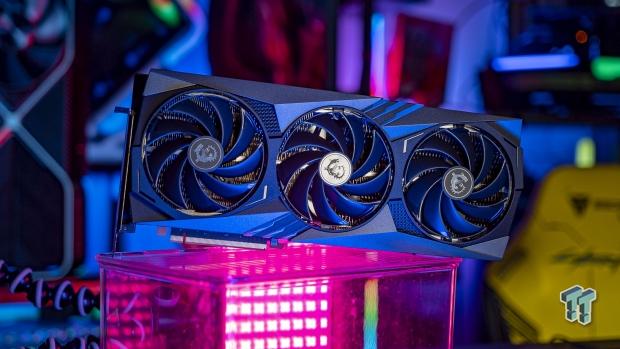
The Bottom Line
Pros
- + 4K 120FPS gaming!
- + MSI TRI FROZR 3 themal solution
- + Super quiet, super chill during gaming
Cons
- - No DisplayPort 2.1 connectivity... why!
Should you buy it?
AvoidConsiderShortlistBuyIntroduction
MSI graciously sent over their new custom GeForce RTX 4080 GAMING X TRIO graphics card for review, which I've compared against NVIDIA's in-house GeForce RTX 4080 Founders Edition and MSI's higher-end custom GeForce RTX 4080 SUPRIM X graphics card.
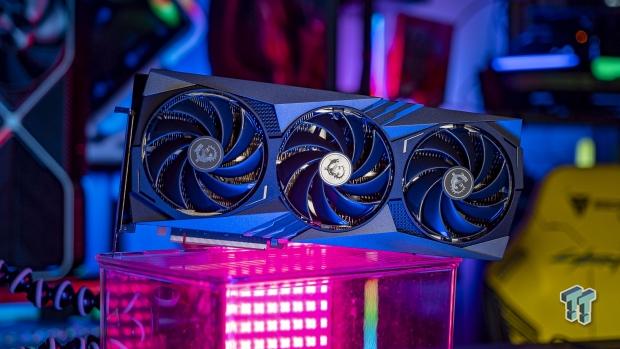
The new MSI GeForce RTX 4080 GAMING X TRIO graphics card is an evolution of their GAMING X TRIO family, reflecting the "spirit of gamers" and the intense performance inside of the card -- the new AD103 "Ada Lovelace" GPU and 16GB of GDDR6X memory -- with a styled exterior with RGB lighting, bold lines, and edges. I prefer the look and style of the SUPRIM X variant, but performance-wise you wouldn't tell the difference between the two.
MSI uses its fantastic TRI FROZR 3 thermal design, with a triple-fan heatsink on the front that keeps everything underneath as cool as possible, something that I'll go into more detail in the review. We have Torx Fan 5.0 that MSI has made fan design improvements to, increasing air pressure and flow into the heatsink. MSI uses ring arcs that link three sets of fan blades that tilt 22 degrees together to maintain high-pressure airflow, even at slower rotational speeds. This results in boosted airflow by 23% compared to an axial fan.
- Read more: NVIDIA GeForce RTX 4090 Founders Edition Review
- Read more: MSI GeForce RTX 4090 SUPRIM LIQUID X Review
- Read more: MSI GeForce RTX 4090 SUPRIM X Review
Underneath, MSI is using a copper baseplate that takes heat directly from the AD103 GPU and 16GB GDDR6X memory modules into a solid nickel-plated copper baseplate that is then transferred into a slew of heat pipes. MSI has widened the thermal transfer systems with highly efficient mechanisms that improve overall efficiency.
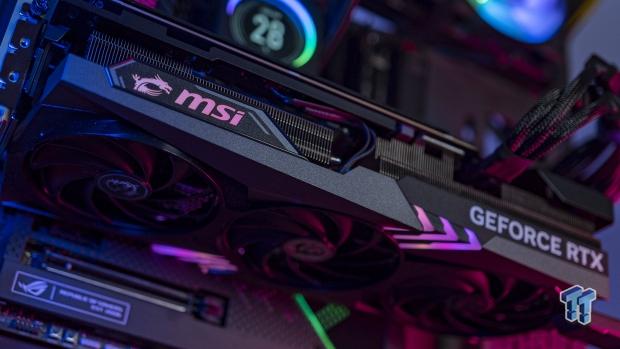
Not only that, but Core Pipes are precision-crafted to make maximum use of the available space inside MSI's custom TRI FROZR 3 thermal solution... where a squared section of the heat pipes fully touches the GPU baseplate, spreading the heat along the full length of the heatsink.
pricing

Ada Lovelace
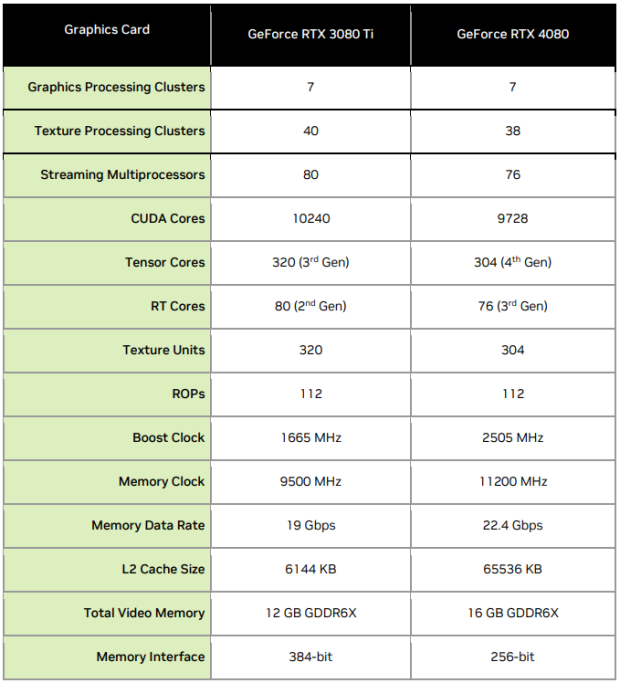
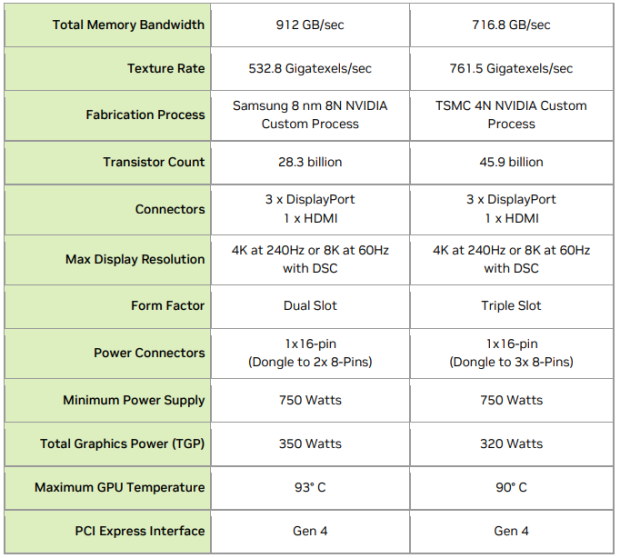
Detailed Look
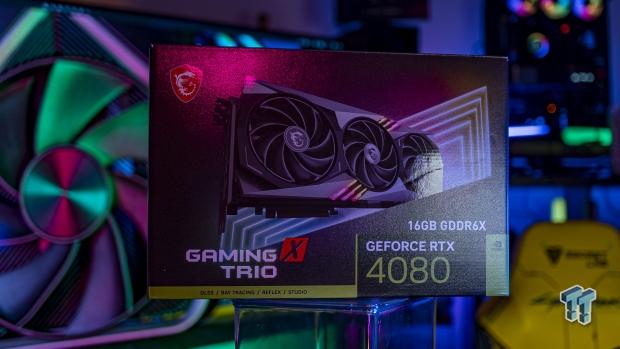
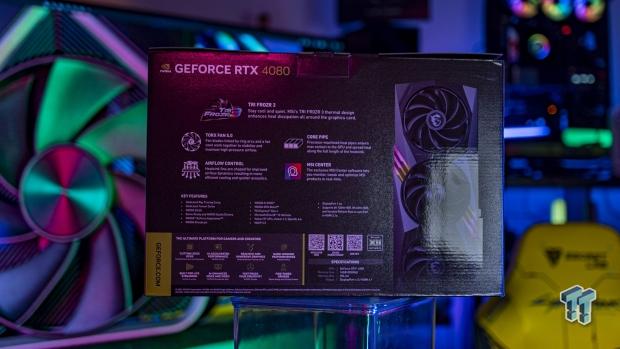
I did get something new this time around: MSI's new GeForce RTX 4080 GAMING X TRIO... the company didn't send over a GAMING X TRIO variant of the GeForce RTX 4090, so it's cool to see GAMING X TRIO with the Ada Lovelace GPU architecture spooling around underneath. Retail packaging is nice, and hasn't changed that much for a GAMING X TRIO graphics card.
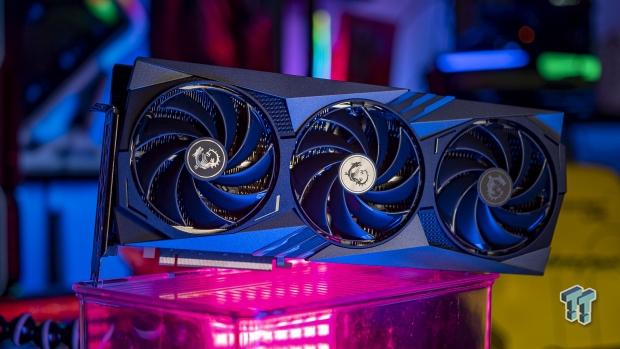
MSI uses a triple-fan TRI FROZR 3 thermal solution on its GeForce RTX 4080 GAMING X TRIO graphics card, ensuring the card stays cool no matter what you're doing on it. MSI says that its GAMING series graphic cards reflects both the spirit of gamers and the intense performance within the cards with a styled exterior that erupts with colorful lights between bold lines and edges.
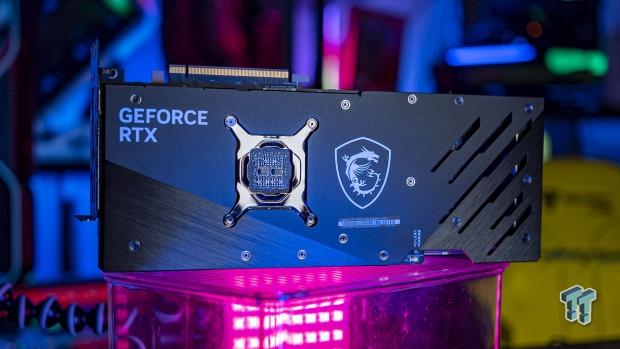
The backplate on the MSI GeForce RTX 4080 GAMING X TRIO isn't anywhere near as fancy as the SUPRIM X variant, so if you can find the SUPRIM X card for a little more money and like the backplate style more, you know what to do.


We have a triple-slot design for the card, falling in line with NVIDIA's own in-house GeForce RTX 4080 Founders Edition graphics card.
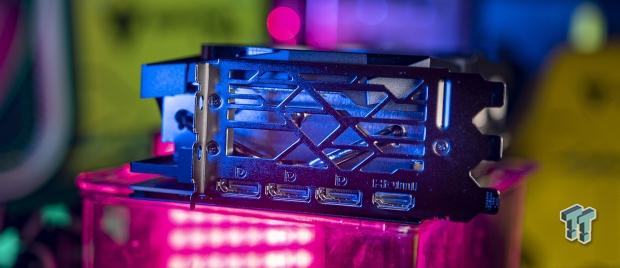
And finally, we have the usual display configuration: 3 x DisplayPort 1.4 connectors and a single HDMI 2.1 port that are all good for 4K 120FPS+ monitors and TVs.
Test System Specs
I've recently upgraded my major GPU test bed for 2022, but I will be upgrading again soon enough once Intel launches its new 13th Gen Core "Raptor Lake" CPUs and Z790 motherboards, and AMD with its upcoming Ryzen 7000 series "Zen 4" CPUs and X670E motherboards.
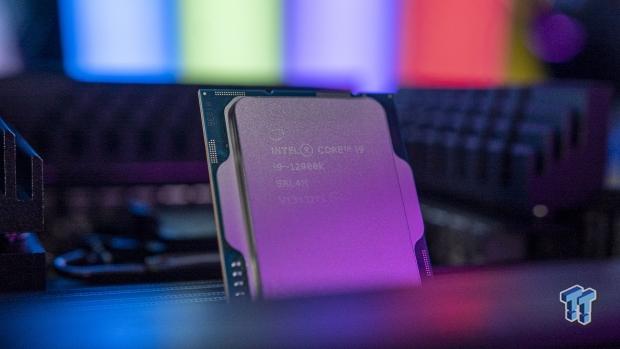
The new upgrades include the shift to the Intel Core i9-12900K processor, ASUS ROG Maximus Z690 Extreme motherboard, 64GB of Sabrent Rocket DDR5-4800 memory, and 8TB of Sabrent Rocket 4 Plus PCIe 4.0 M.2 SSD goodness. Intel's flagship Core i9-12900K is a beast, with the Alder Lake CPU packing 8 Performance cores (P-cores) and 8 Efficient cores (E-cores) at up to 5.2GHz.
Motherboard: ASUS ROG Maximus Z690 Extreme
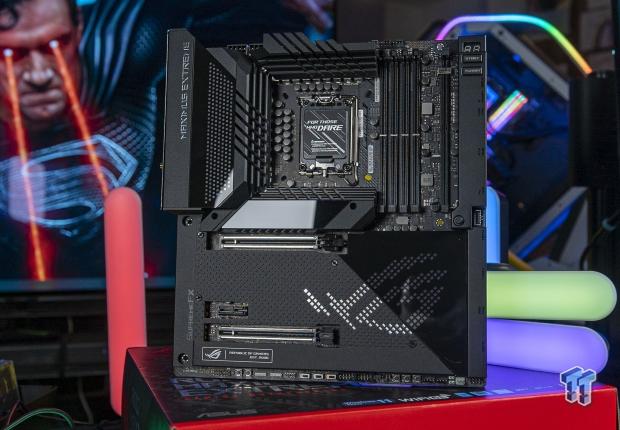
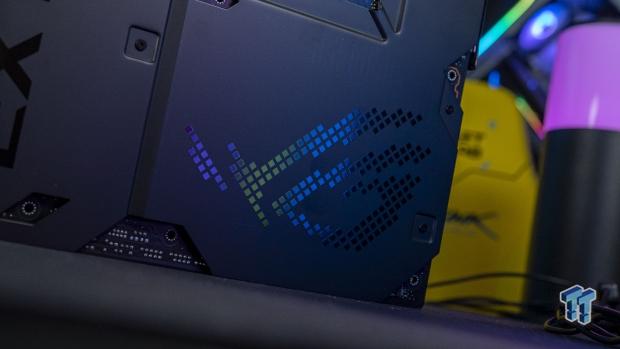
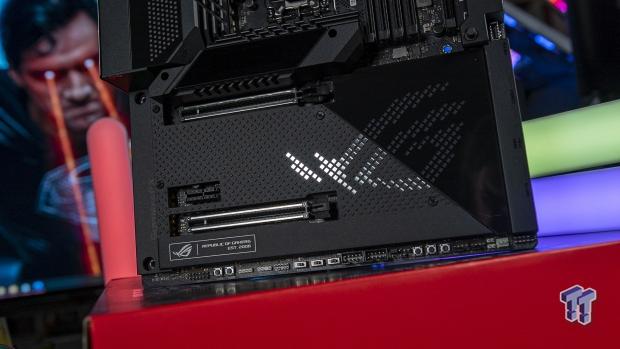
I've got that installed into the bigger-than-life ASUS ROG Maximus Z690 Extreme motherboard, which is absolutely loaded to the brim with technologies and features that it houses everything you need. We're talking about one of the best-looking designs on a motherboard yet, PCIe 5.0 support, enthusiast-grade 10GbE networking, and oh-so-much more.
RAM: 64GB Sabrent Rocket DDR5-4800
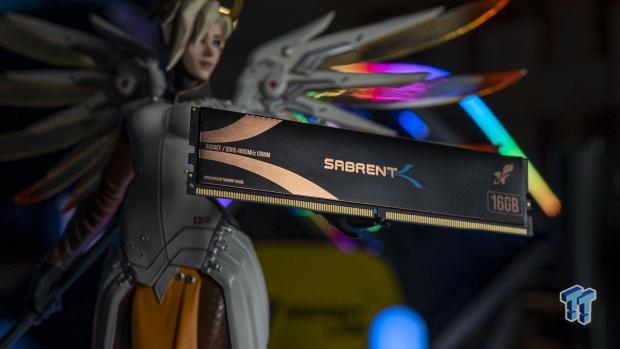
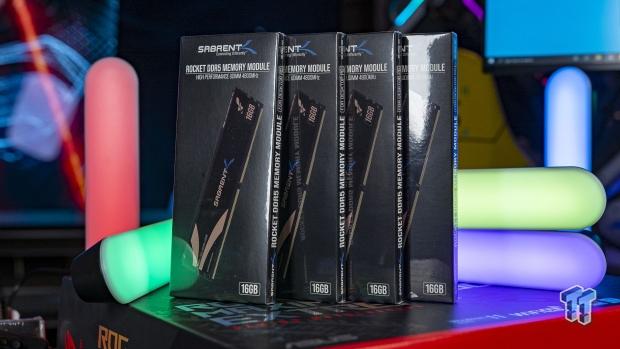
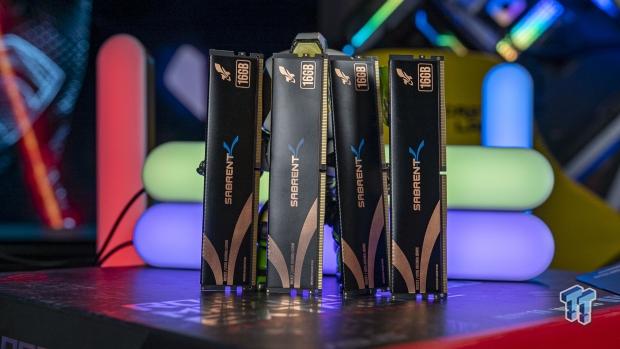
Sabrent helped out in a huge way by sending over 64GB of DDR5-4800 memory in the form of 4 x 16GB DDR5-4800 modules of its new Sabrent Rocket DDR5 memory. The company also helped out in an even bigger way, supplying us with a gigantic and super-fast 8TB model of its Sabrent Rocket 4 Plus PCIe 4.0 NVMe M.2 SSD.
SSD: 8TB Sabrent Rocket 4 Plus M.2
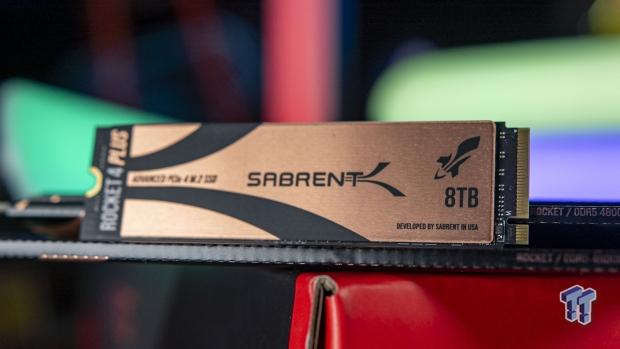
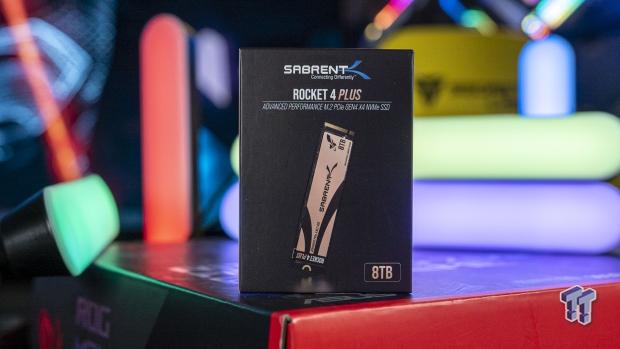
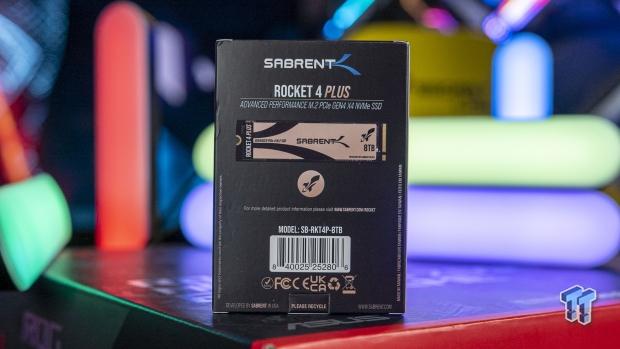
We're talking about 7.5GB/sec+ (7500MB/sec) from a single M.2 SSD, along with a gigantic 8TB of capacity. The 2TB drives aren't big enough for all of our game installs for GPU testing... the 4TB is much better, but the 8TB gives us room to move into 2023 without worrying about installing multiple games that are 200GB+ in size.
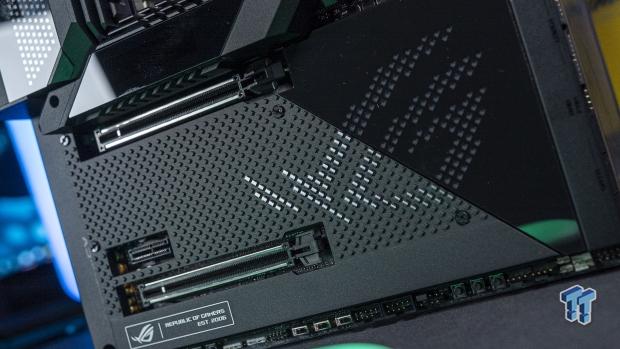



Some glory shots, of course.
Displays: ASUS ROG Strix 43-inch 4K 120Hz
ASUS has been a tight partner of TweakTown for many years, with the fine folks at ASUS Australia sending over their ROG Strix XG438Q and ROG Swift PG43UQ gaming monitors for our GPU test benches. They're both capable of 4K 120Hz+ through their DisplayPort 1.4 connectivity.
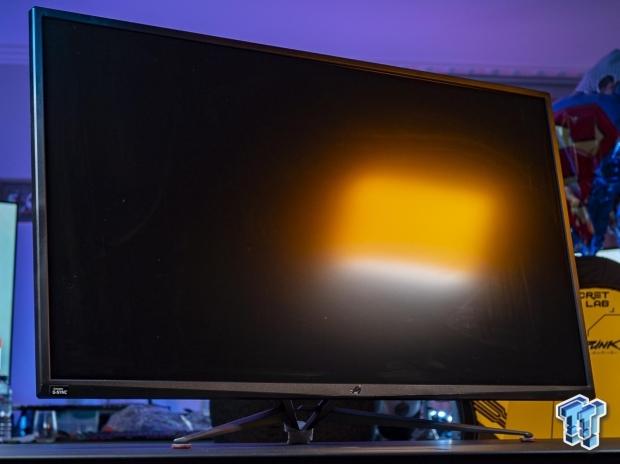
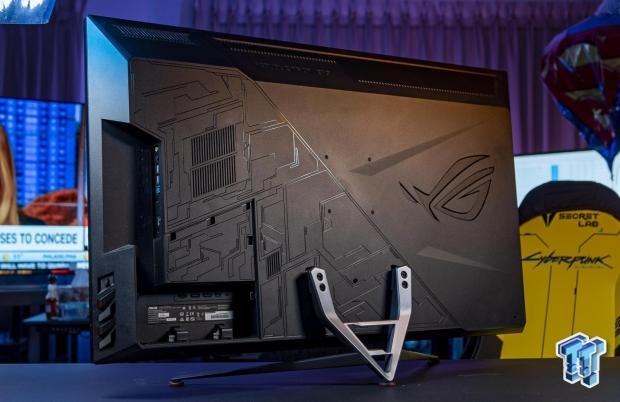
I will be upgrading these in the near future, over to some DisplayPort 2.0-capable panels and some new HDMI 2.1-enabled 4K 165Hz panels in OLED form of course...given that next-gen GPUs are right around the corner, there has been no better time to upgrade your display or TV.
I've been working on this system for a while now, but now we're stretching its legs with the newly-released PC port of Marvel's Spider-Man Remastered. Not just in 1080p or 1440p, not even in just 4K... but at 8K with a native resolution of 7680 x 4320. I've run through some of the very fastest GPU silicon on the planet.
- CPU: Intel Core i9-12900K (buy from Amazon)
- Motherboard: ASUS ROG Maximus Z690 Extreme (buy from Amazon)
- Cooler: CORSAIR iCUE H150i ELITE LCD Display (buy from Amazon)
- RAM: Sabrent Rocket 64GB DDR5-4800 (4 x 16GB) (F4-3600C18Q-32GTZN) (buy from Amazon)
- SSD: Sabrent 8TB Rocket 4 Plus PCIe 4.0 NVMe M.2 SSD (buy from Amazon)
- PSU: MSI MPG A1000G Gaming Power Supply 1000W (buy from Amazon)
- Case: InWin X-Frame 2.0
- OS: Microsoft Windows 11 Pro x64 (buy from Amazon)
- Display: ASUS ROG Swift PG43UQ (4K 120Hz) (buy from Amazon)
Benchmarks - Synthetic
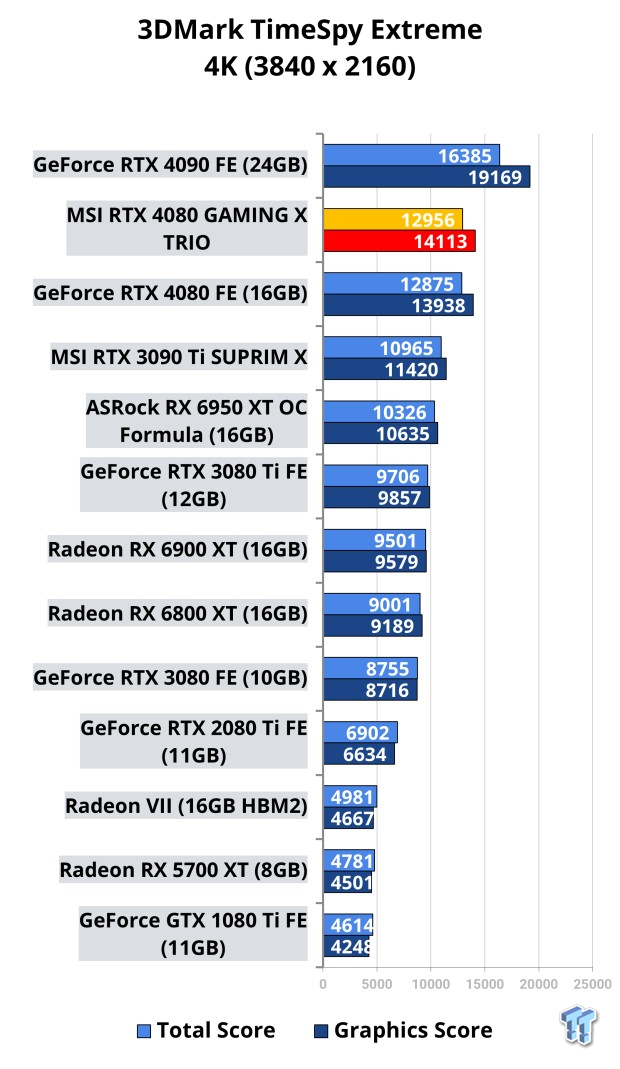
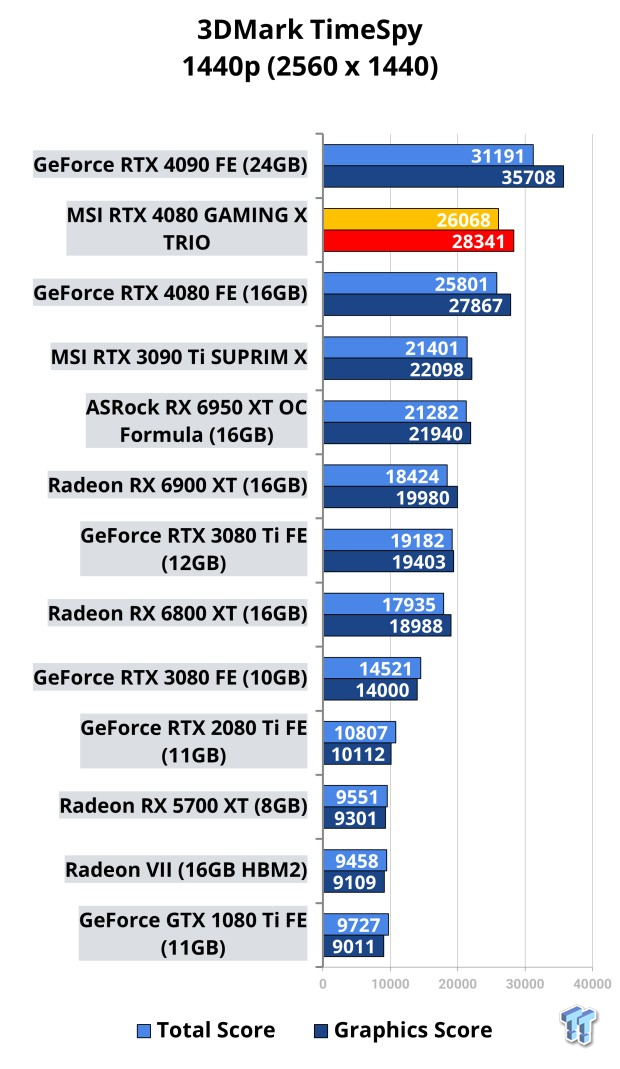
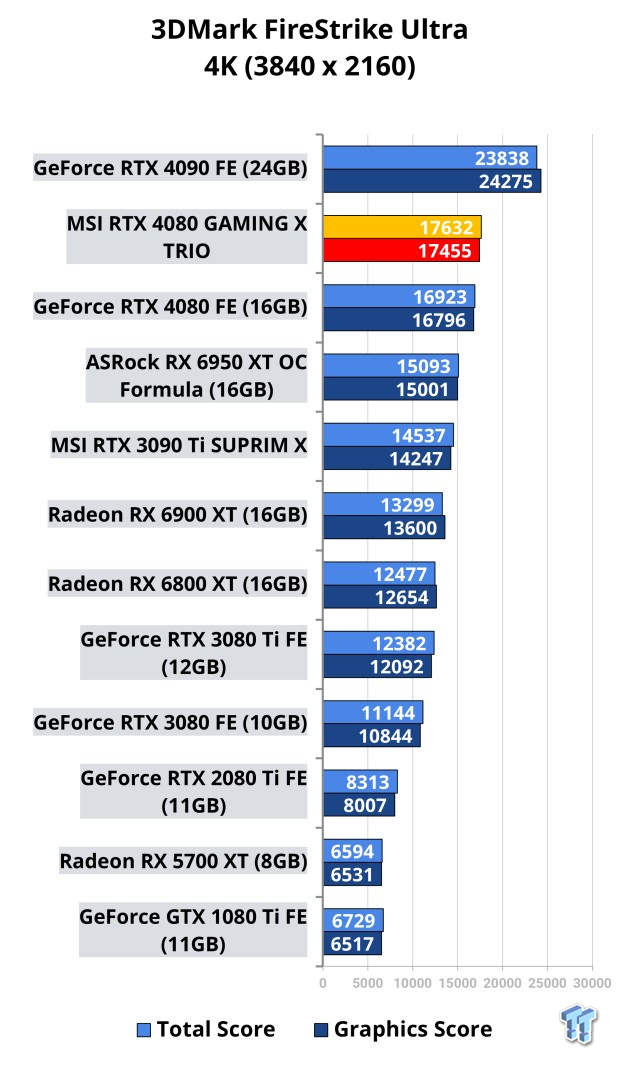
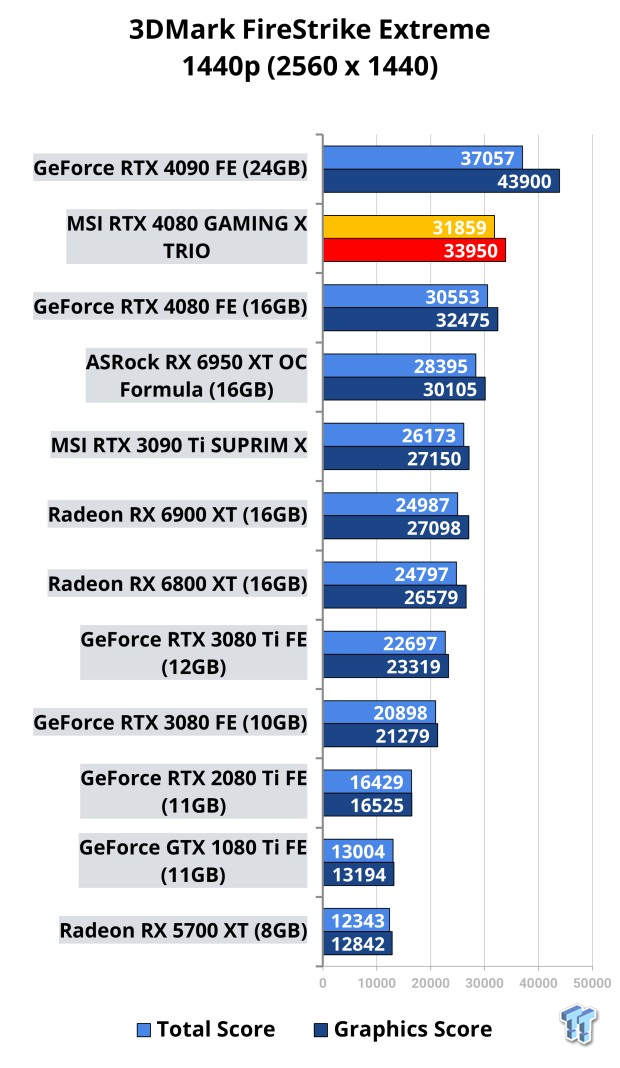
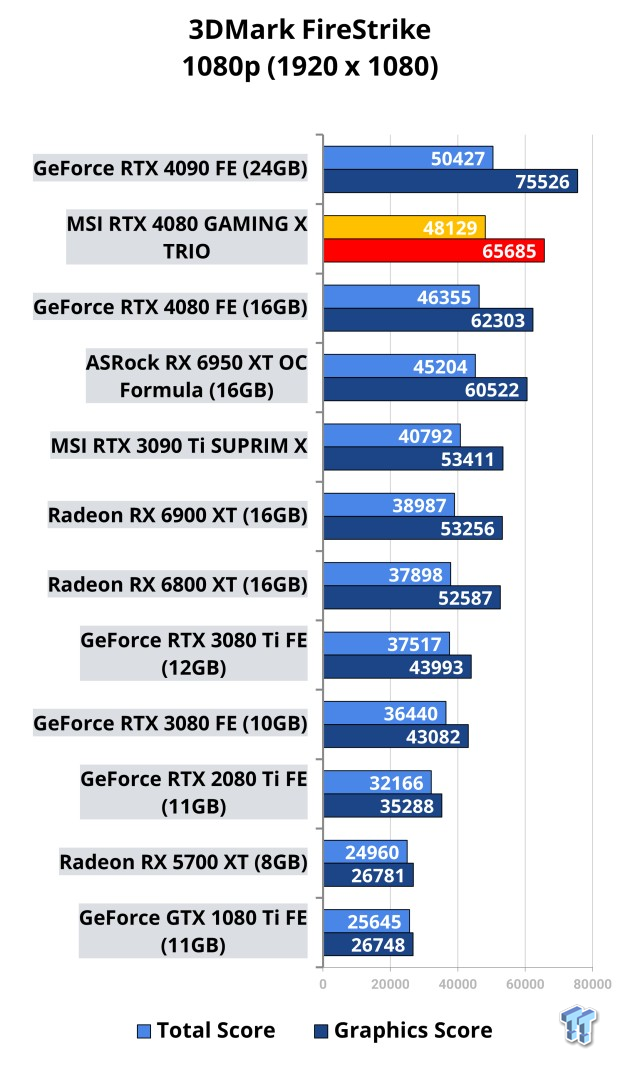
Benchmarks - 1080p
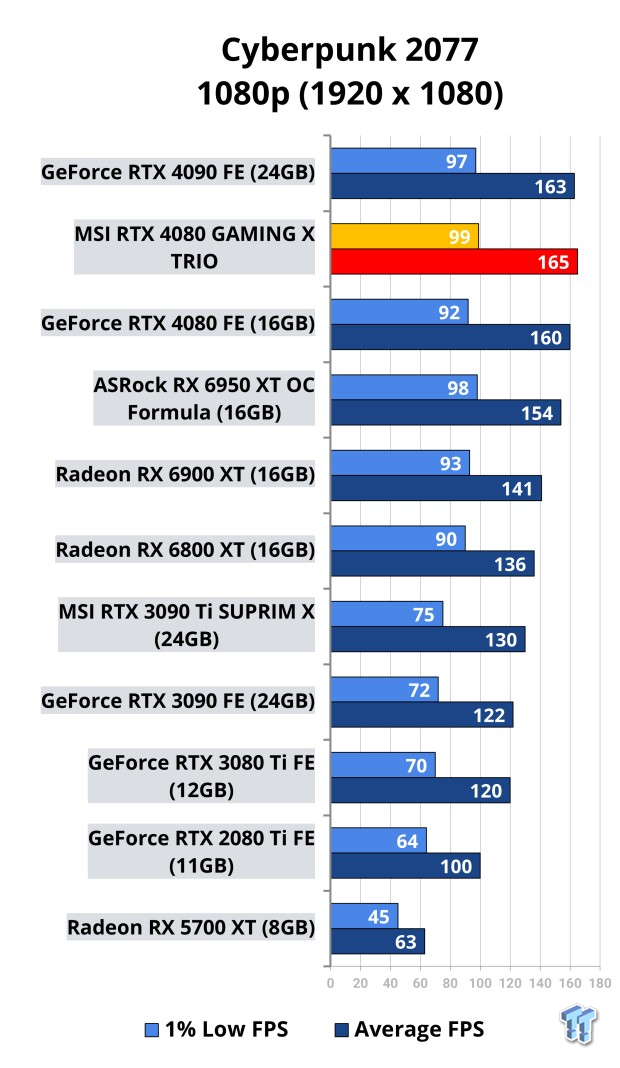
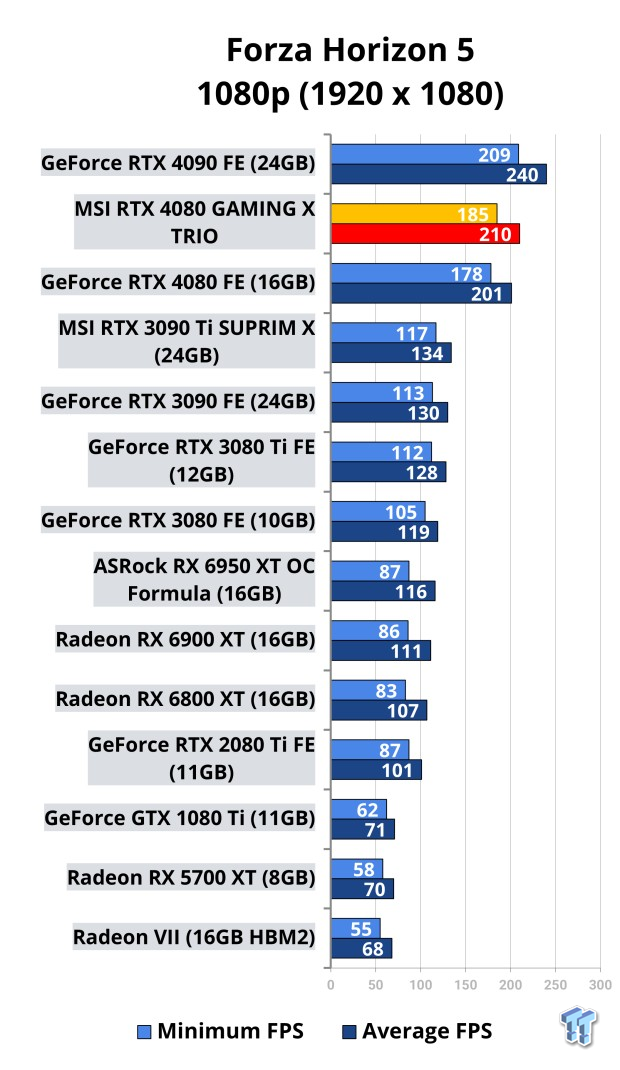
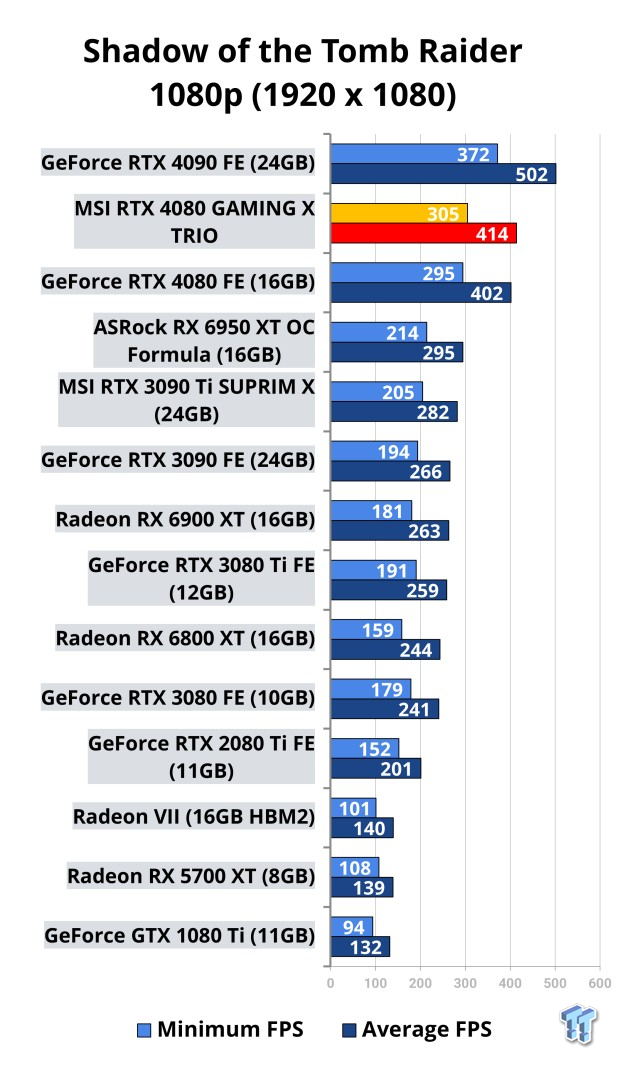
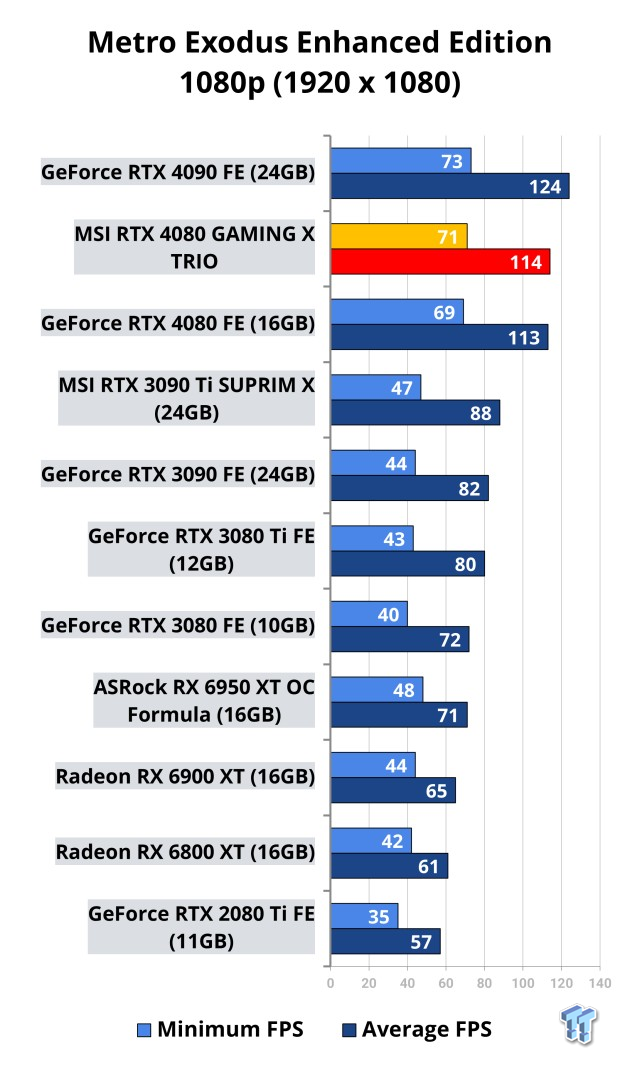
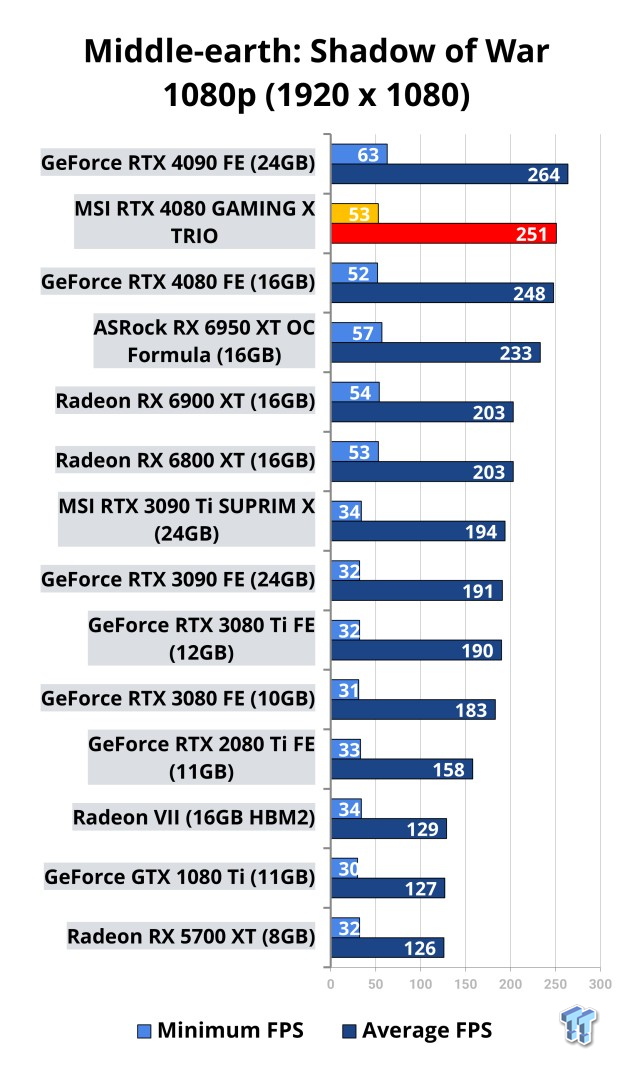
Benchmarks - 1440p
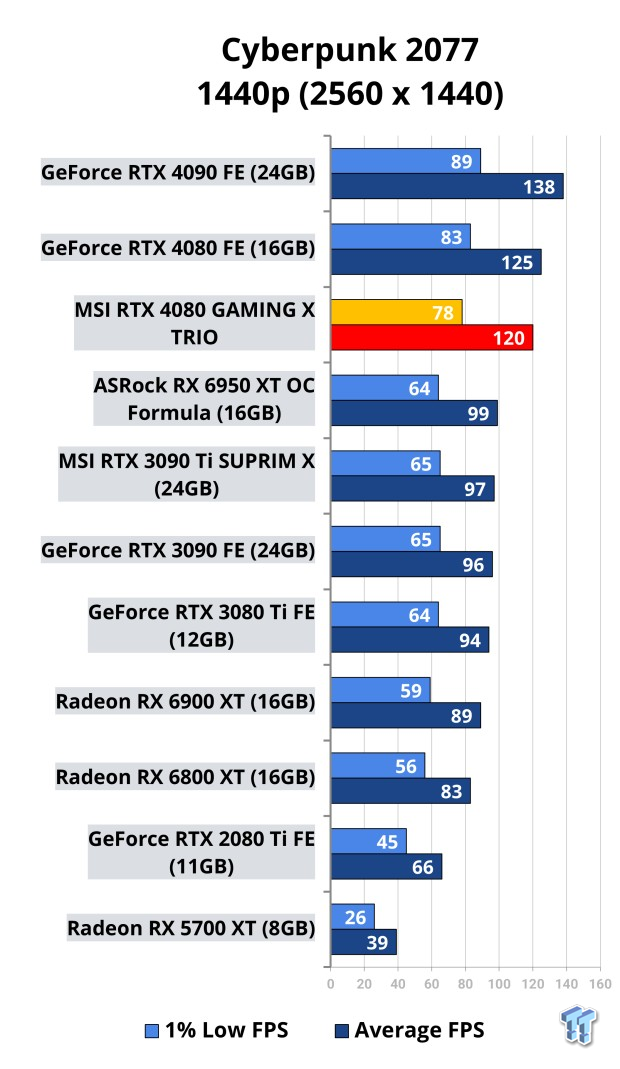
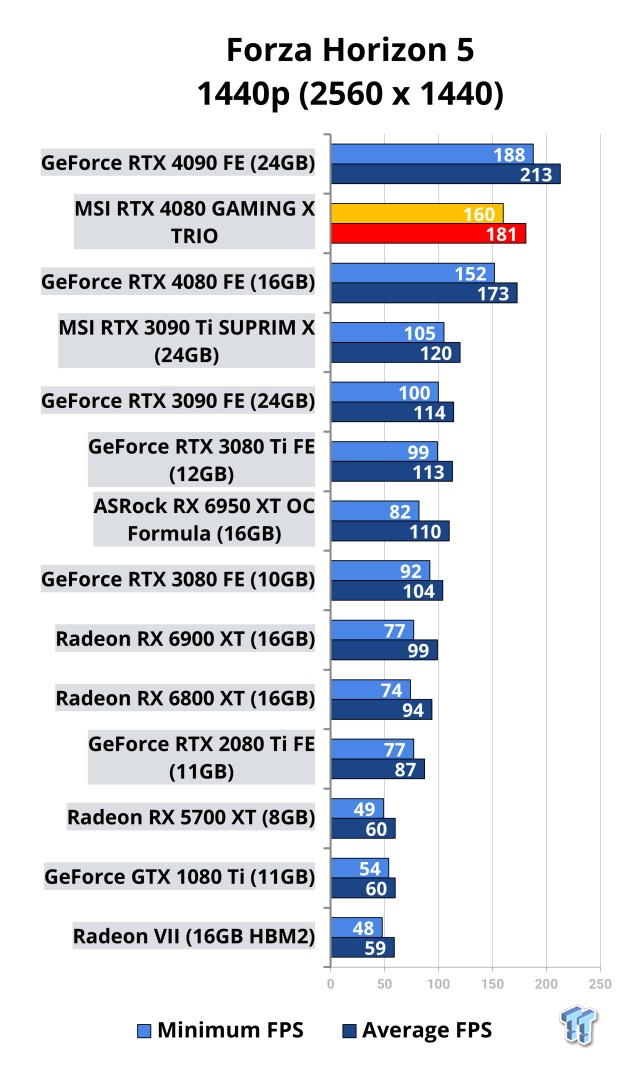
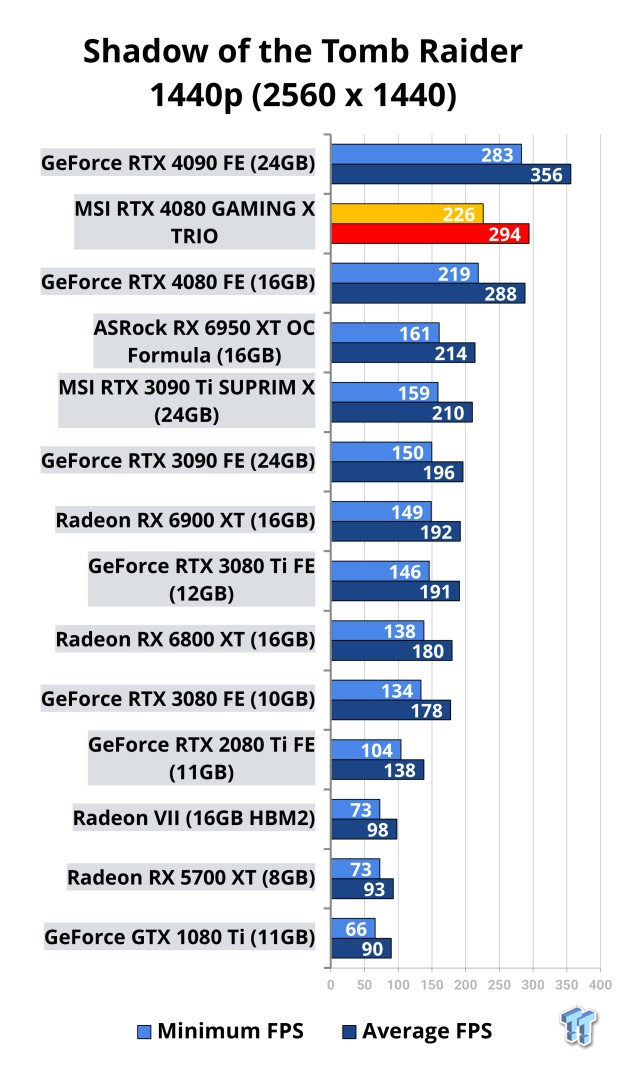
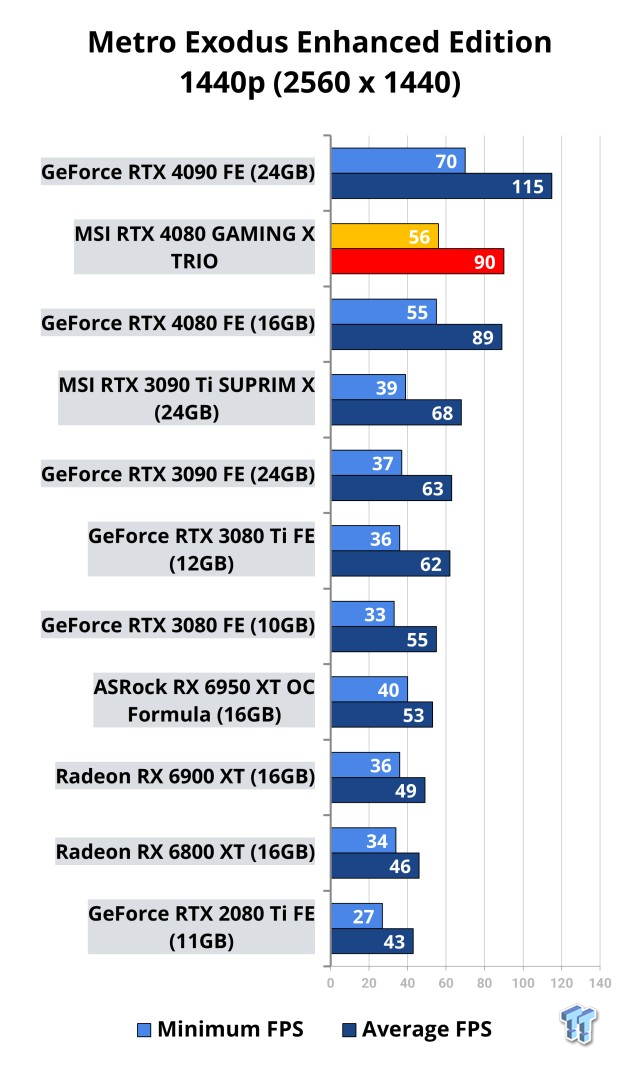
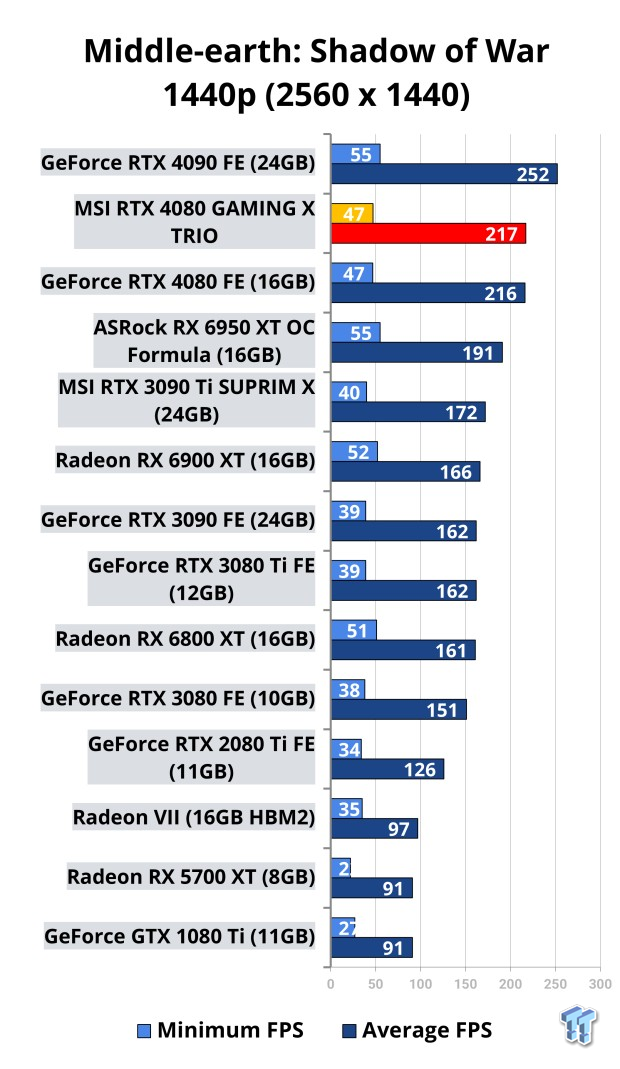
Benchmarks - 4K
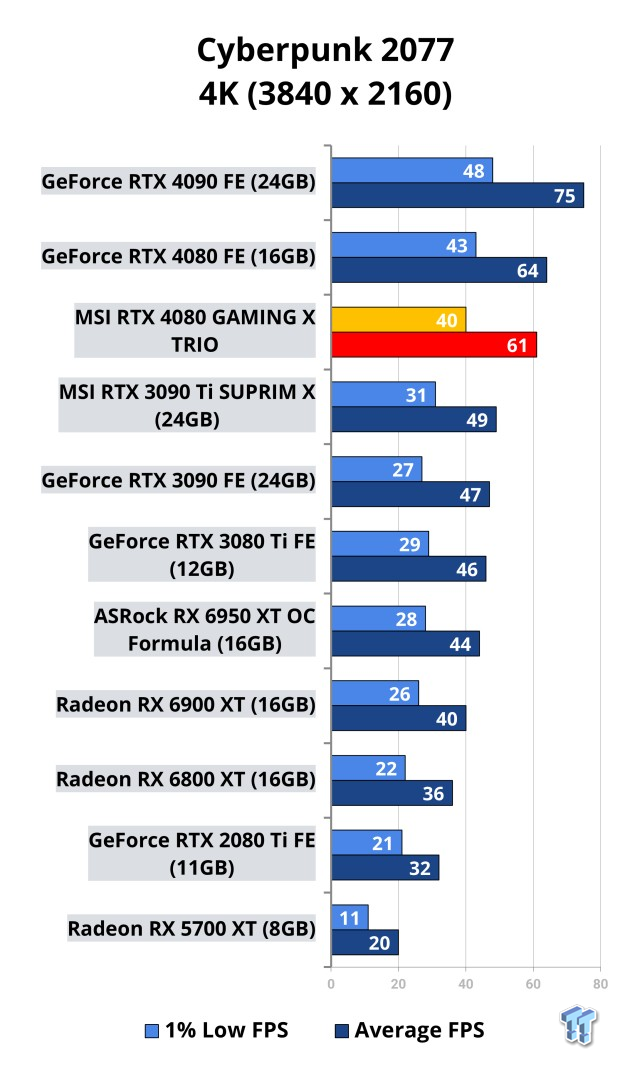
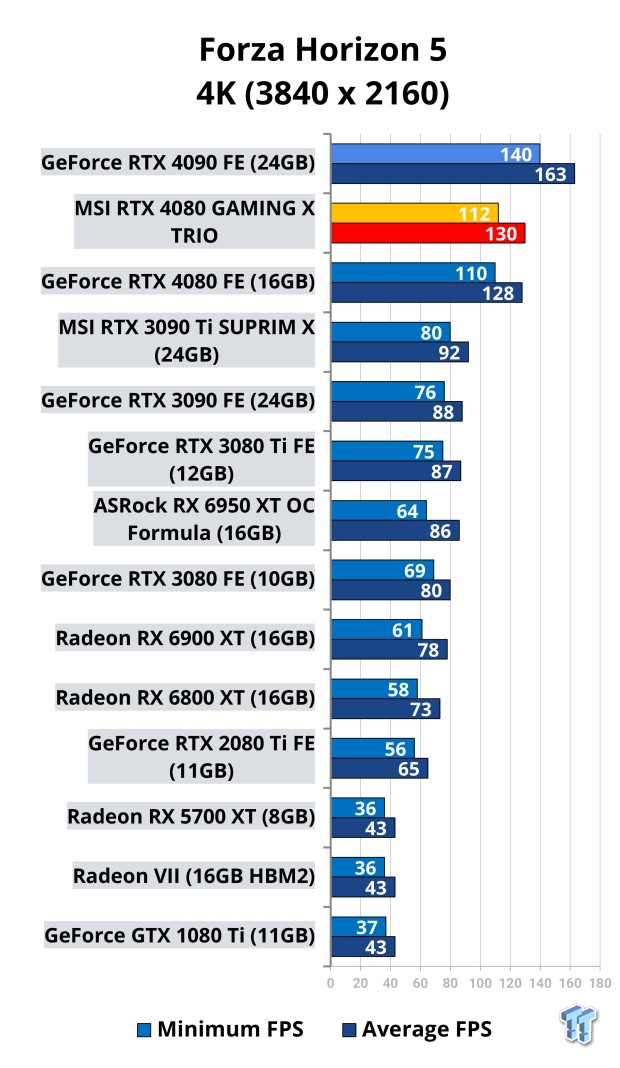
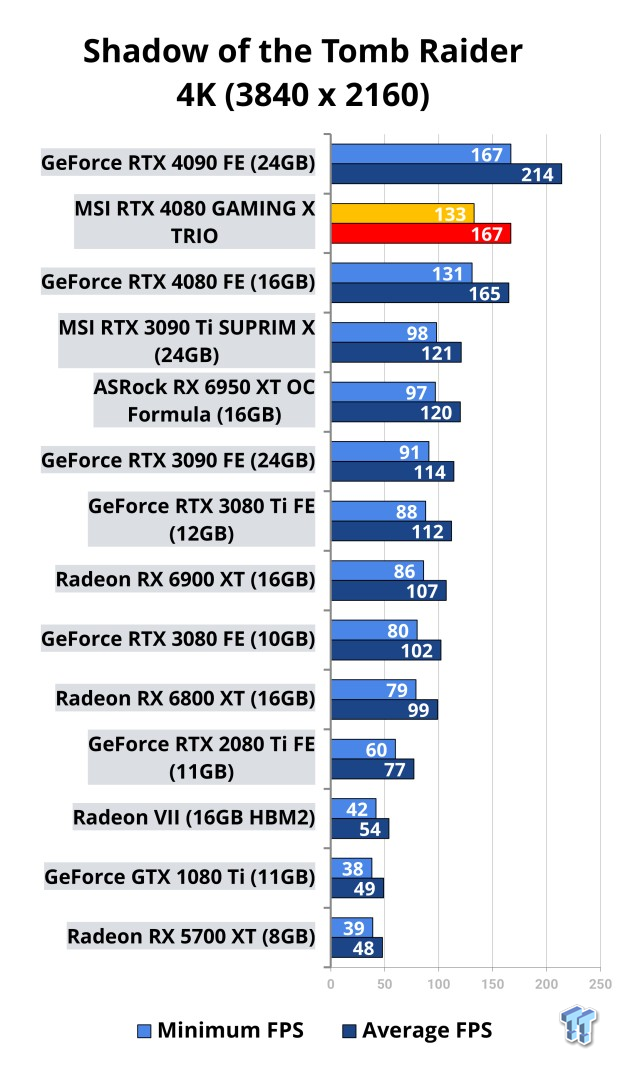
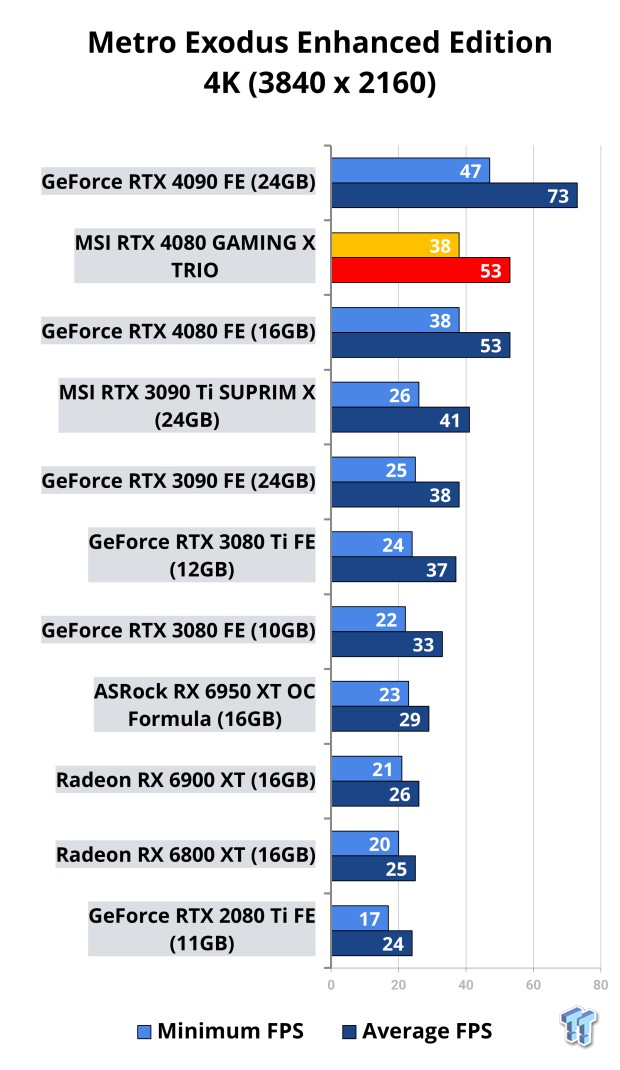
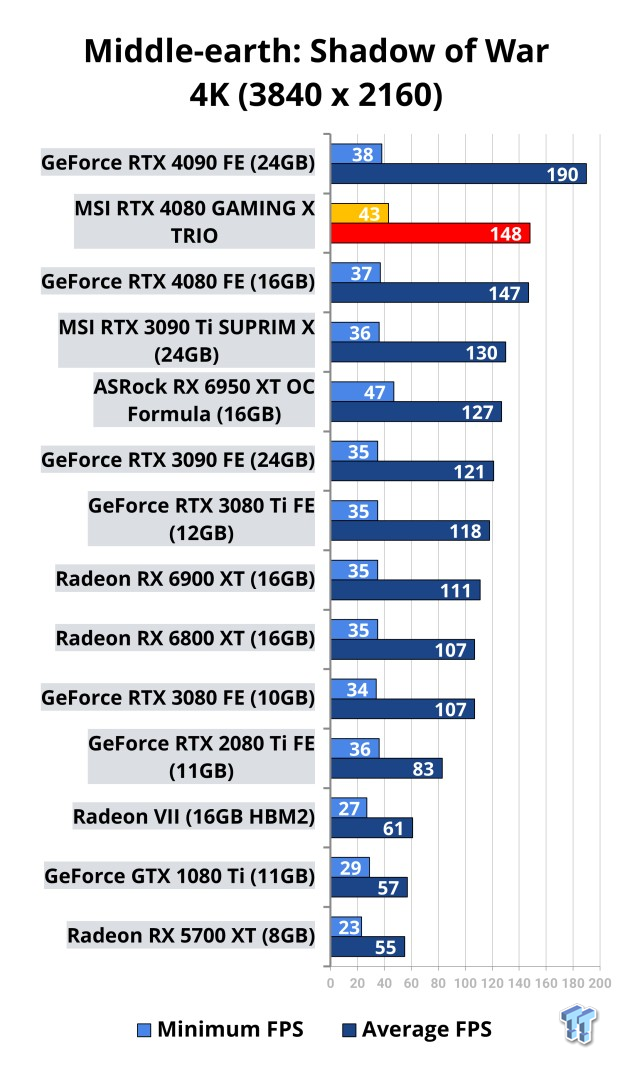
Temps & Power Consumption
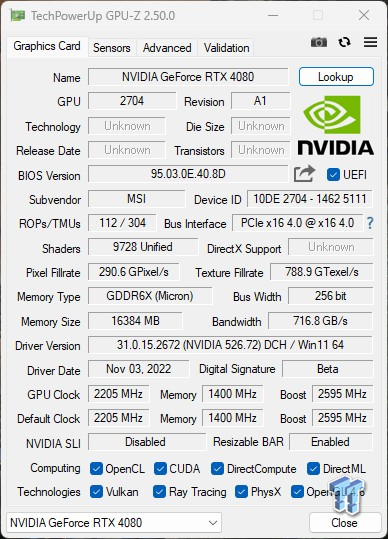
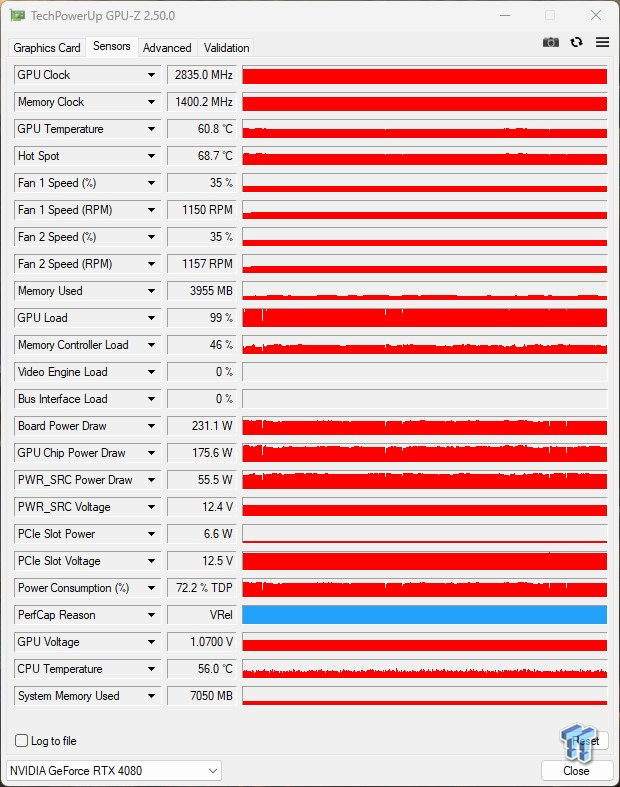
MSI's new custom GeForce RTX 4080 GAMING X TRIO keeps things nice and cool with its TRI FROZR 3 thermal system, with GPU temps sitting at 60-61C max under full load, while GPU hot spot temperatures sit at under 69C. This is with fans at default: 1150RPM or so (35%).
What's Hot, What's Not
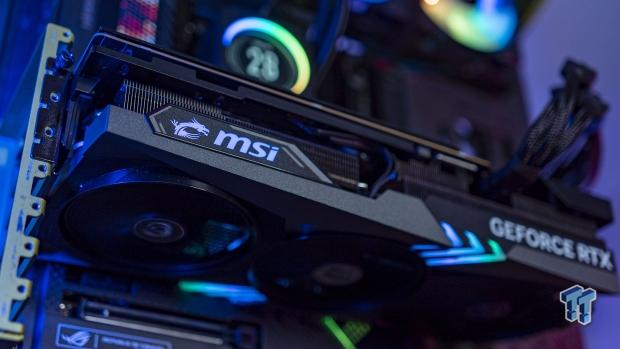
What's Hot
- 4K 120FPS+ gaming performance: You've got the kick-ass AD103 GPU + 16GB GDDR6X memory for 4K 120FPS+ gaming, or if you've got a 1440p or ultrawide gaming monitor then rest assured: you will be able to crank up every visual dial to the max.
- MSI's impressive TRI FROZR 3 thermal solution: Super chilly to run under full stress, no matter what game or benchmark you throw at the MSI GeForce RTX 4080 GAMING X TRIO, the TRI FROZR 3 thermal solution has your back.
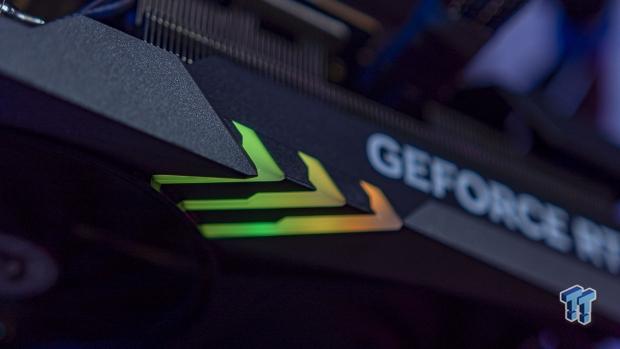
- TSMC 4N process node: NVIDIA has been limping along using a custom 8nm process node at Samsung, but now they've been unshackled with Ada Lovelace being made on TSMC's new 4N process node (which in reality, is 5nm, but "4N" is for NVIDIA).
- DLSS 3: I say this with every evolution, but DLSS is like black magik -- only this time, NVIDIA has sacrificed something (Jensen, maybe) to the AI upscaling technology gods. DLSS 3 is freaking incredible, truly offering double, triple, and sometimes even more performance over native rendering. It's simply amazing to sit back and watch Microsoft Flight Simulator or Cyberpunk 2077 go from 60FPS or so, to 150FPS+ with a few button presses enabling DLSS 3.
- Ray tracing + DLSS 3 = more FPS than no ray tracing: DLSS 3 super-powers any game that's blessed enough to feature Ada's exclusive upscaling technology, whereas in games like Cyberpunk 2077 turning DLSS 3 on allows you to run ray tracing with MORE performance, not less.
What's Not
- No DisplayPort 2.0 connector, WTF: NVIDIA not including the new display connector moving forward -- DP2.0 -- is a huge mistake. It means anyone buying a $1500+ graphics card in the tail end of 2022 is not going to be able to use next-gen DP2.0-capable gaming monitors that we'll begin seeing debut in the coming months, probably at CES 2023 in January. WTF, NVIDIA? Even Intel's is-it-even-real Arc GPUs have a DP2.0 port.
Final Thoughts
MSI's new GeForce RTX 4080 GAMING X TRIO will impress any gamer, especially if you skipped over the GeForce RTX 30 series GAMING X TRIO graphics cards from MSI. It's freaking fast, thrashing the GeForce RTX 3090 and GeForce RTX 3090 Ti GAMING X TRIO graphics cards that MSI had during the previous-gen Ampere GPU days.
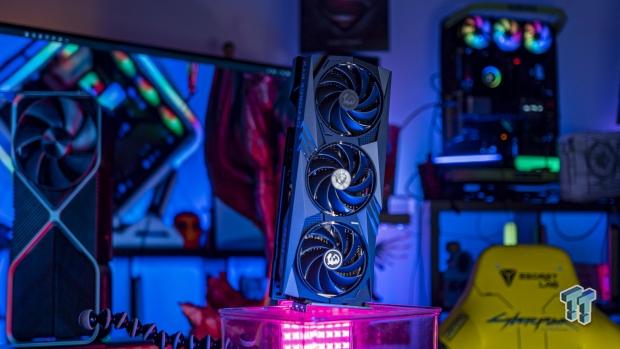
The card looks fantastic from the front but the backplate is a big step down from the MSI GeForce RTX 4080 SUPRIM X... if backplates are your thing, that is. Still, underneath it has everything that will drive you 1080p 240FPS+, 1440p 240FPS+, ultrawide, and 4K 120FPS+ gaming monitors and TVs... NVIDIA's new AD103 GPU and 16GB of GDDR6X memory.
If you are playing games with ray tracing or more specifically, DLSS 3, then you're in for an absolutely magical time. In pure rasterization, MSI's new GeForce RTX 4080 GAMING X TRIO will slay through every game you've got, and games that aren't released yet. You will also not be cooking your room and turning it into a sauna, with the TRI FROZR 3 thermal solution keeping temps at bay (and a big leap over the Ampere-based RTX 3090 and RTX 3090 Ti graphics cards).
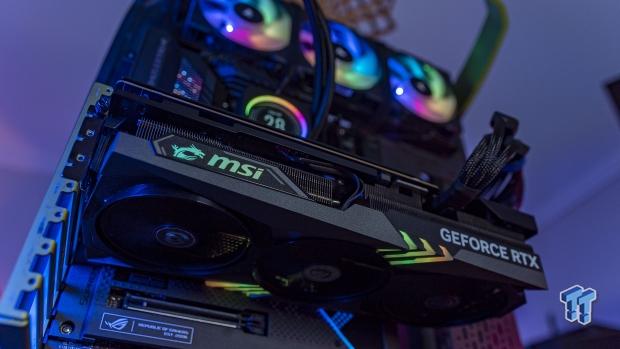
The only thing that I would suggest is that if you haven't completely made your mind up over NVIDIA's new GeForce RTX 4080 and AMD's upcoming RDNA 3-based Radeon RX 7900 XTX (which will be the direct competitor to the RTX 4080) then wait a few weeks to pull the trigger on the MSI GeForce RTX 4080 GAMING X TRIO. I'm sure the company will be debuting a Radeon RX 7900 XTX GAMING X TRIO (or similar) that will be a Navi 31-based competitor to the AD103-based GeForce RTX 4080... and it'll be cheaper.
But, you will be missing out on NVIDIA-exclusive technologies like DLSS 3, powerhouse ray tracing performance, NVIDIA Reflex, and many other technologies. AMD is slowly catching up, but NVIDIA has the kitchen sink and more inside of its new Ada Lovelace GPU architecture and GeForce RTX 4080.
MSI does it again with the GeForce RTX 4080 GAMING X TRIO, offering stellar performance from NVIDIA's new AD103 "Ada Lovelace" GPU, 16GB of GDDR6X, and slapping its usual GAMING X TRIO aesthetic and TRI FROZR 3 thermal solution. You won't regret throwing one of these into your gaming PC, that's for sure.

